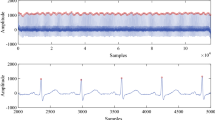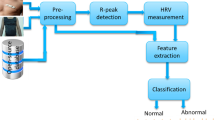Abstract
Holter recordings are widely used to detect cardiac events that occur transiently, such as ischemic events. Much effort has been made to detect early ischemia, thus preventing myocardial infarction. However, after detection, classification of ischemia has still not been fully solved. The main difficulty relies on the false positives produced because of non-ischemic events, such as changes in the heart rate, the intraventricular conduction or the cardiac electrical axis. In this work, the classification of ischemic and non-ischemic events from the long-term ST database has been improved, using novel spectral parameters based on the continuous wavelet transform (CWT) together with temporal parameters (such as ST level and slope, T wave width and peak, R wave peak, QRS complex width). This was achieved by using a nearest neighbour classifier of six neighbours. Results indicated a sensitivity and specificity of 84.1% and 92.9% between ischemic and non-ischemic events, respectively, resulting a 10% increase of the sensitivity found in the literature. Extracted features based on the CWT applied on the ECG in the frequency band 0.5–4 Hz provided a substantial improvement in classifying ischemic and non-ischemic events, when comparing with the same classifier using only temporal parameters.

In this work it is improved the classification of ischemic and non-ischemic events. The main difficulty of ischemic detectors relies on the false positives produced because of non-ischemic events. After a preprocessing stage, temporal and spectral parameters are extracted from events of the Long Term ST Database. The novel parameters proposed in this work are extracted from the Continuous Wavelet Transform. A nearest Neighbor Classifier is used, obtaining a sensitivity and specificity of 84.1% and 92.9%, respectively.





Similar content being viewed by others
Abbreviations
- ASE :
-
Axis shift event
- CCE :
-
Conduction change event
- CP :
-
Control period
- CWT :
-
Continuous wavelet transform
- ECG :
-
Electrocardiogram
- HRE :
-
Heart rate event
- ISE :
-
Ischemic event
- LTST DB :
-
Long-term ST database
- NISE :
-
Non-ischemic event
- SSE :
-
Sudden step event
- STE :
-
ST event
- TE :
-
Transient event
References
Addison P (2017) Complex wavelets: the Morlet wavelet. In: The illustrated wavelet transform handbook: introductory theory and applications in science, engineering, medicine and finance, pp 35–45. CRC Press
Amon M, Jager F (2016) Electrocardiogram ST-segment morphology delineation method using orthogonal transformations. PLoS ONE 11(2):1–18. https://doi.org/10.1371/journal.pone.0148814
Ansari S, Farzaneh N, Duda M, Horan K, Andersson HB, Goldberger ZD, Nallamothu BK, Najarian K (2017) A review of automated methods for detection of myocardial ischemia and infarction using electrocardiogram and electronic health records. IEEE Rev Biomed Eng 10:264–298. https://doi.org/10.1109/RBME.2017.2757953
Badilini F, Moss AJ, Titlebaum EL (1991) Cubic spline baseline estimation in ambulatory ECG recordings for the measurement of ST segment displacements. In: Annual international conference of the IEEE Engineering in Medicine and Biology Society (EMBS), vol 13, pp 584–585. https://doi.org/10.1109/IEMBS.1991.684093
Banerjee S, Mitra M (2012) Cross wavelet transform based analysis of electrocardiogram signals. Int J Elect Electron Comput Eng 1(2):88–92
Cover TM, Hart PE (1967) Nearest neighbor pattern classification. IEEE Trans Inform Theory IT-13(1):21–27
Demski AJ, Soria ML (2016) ecg-kit a matlab toolbox for cardiovascular signal processing. J Open Res Softw 4:2–5. https://doi.org/10.5334/jors.86
Gamero LG, Vila J, Palacios F (2002) Wavelet transform analysis of heart rate variability during myocardial ischaemia. Med Biol Eng Comput 40(1):72–78. https://doi.org/10.1007/BF02347698
García J, Sörnmo L, Olmos S, Laguna P (2000) Automatic detection of ST-T complex changes on the ECG using filtered RMS difference series: application to ambulatory ischemia monitoring. IEEE Trans Biomed Eng 47(9):1195–1201. https://doi.org/10.1109/10.867943
Goldberger A, Amaral L, Glass L, Hausdorff J, Ivanov P, Mark R, Mietus J, Moody G, Penk C, Stanley H (2000) PhysioBank, PhysioToolkit, and PhysioNet: components of a new research resource for complex physiologic signals. Circulation 23:e215–e220
Gramatikov B, Brinker J, Yi-chun S, Thakor NV (2000) Wavelet analysis and time-frequency distributions of the body surface ECG before and after angioplasty. Comput Methods Programs Biomed 62:87–98
Jager F, Moody G, Mark R (1998) Detection of transient ST segment episodes during ambulatory ECG monitoring. Comput Bio Res Int J 31(5):305–22. https://doi.org/10.1006/cbmr.1998.1483
Jager F, Taddei A, Moody GB, Emdin M, Antolič G, Dorn R, Smrdel A, Marchesi C, Mark R (2003) Long-term ST database: a reference for the development and evaluation of automated ischaemia detectors and for the study of the dynamics of myocardial ischaemia. Med Biol Eng Comput 41(2):172–182. https://doi.org/10.1007/BF02344885
Langley P, Bowers E, Wild J, Drinan M, Allen J, Sims A, Brown N, Murray A (2003) An algorithm to distinguish ischaemic and non-ischaemic ST changes in the holter ECG. Comput Cardiol 30:239–242
Lemire D, Pharand C, Rajaonah JC, Dubé B, Robert Leblanc A (2000) Wavelet time entropy, T wave morphology and myocardial ischemia. IEEE Trans Biomed Eng 47(7):967–970. https://doi.org/10.1109/10.846692
Manocha AK, Singh M (2011) An overview of ischemia detection techniques. Int J Sci Eng Res 2(11):1–5
Meyer CR, Keiser HN (1977) Electrocardiogram baseline noise estimation and removal using cubic splines and state-space computation techniques. Comput Biomed Res 10(5):459–470. https://doi.org/10.1016/0010-4809(77)90021-0
Mincholé A, Jager F, Laguna P (2010) Discrimination between ischemic and artifactual ST segment events in Holter recordings. Biomed Signal Process Control 5(1):21–31. https://doi.org/10.1016/j.bspc.2009.09.001
Moody G, Jager F (2003) Distinguishing ischemic from non-ischemic ST changes: the Physionet/Computers in Cardiology Challenge 2003. Comput Cardiol 2003:235–237. https://doi.org/10.1109/CIC.2003.1291134
Pencina MJ, D’ Agostino RB Sr, D’ Agostino RB Jr, Vasan RS (2008) Evaluating the added predictive ability of a new marker: from area under the ROC curve to reclassification and beyond, pp 157–172. https://doi.org/10.1002/sim
Smrdel A, Jager F (2004) Automated detection of transient ST-segment episodes in 24 h electrocardiograms. Med Bio Eng Comput 42(3):303–311. https://doi.org/10.1007/BF02344704
Taddei A, Distante G, Emdin M, Pisani P, Moody G, Zeelenberg C, Marchesi C (1992) The European ST-T database standard for evaluating systems for the analysis of ST-T changes in ambulatory electrocardiography. Eur Heart J 13:1164–1172
Thygesen K, Alpert JS, Jafe AS, Simoons ML, Chaitman BR, White HD (2012) The third universal definition of myocardial infarction - moving forward. Am Heart Assoc 126:2020–2035. https://doi.org/10.1373/clinchem.2012.196832
Torrence C, Compo GP (1998) A practical guide to wavelet analysis. Bull Am Meteorol Soc 79(1):61–78. https://doi.org/10.1175/1520-0477(1998)079<0061:APGTWA>2.0.CO;2
Funding
This work was supported by Universidad de Buenos Aires (UBACyT 20020130100485BA), by Agencia Nacional de Promoción Científica y Tecnológica (MINCyT PICT 2145 2016) and by Consejo Nacional de Investigaciones Científicas y Técnicas (PIP 2014-2016 112-20130100552CO), Argentina.
Author information
Authors and Affiliations
Corresponding author
Ethics declarations
Conflict of interest
The authors declare that they have no conflict of interest.
Additional information
Publisher’s note
Springer Nature remains neutral with regard to jurisdictional claims in published maps and institutional affiliations.
Rights and permissions
About this article
Cite this article
Fernández Biscay, C., Arini, P.D., Rincón Soler, A.I. et al. Classification of ischemic and non-ischemic cardiac events in Holter recordings based on the continuous wavelet transform. Med Biol Eng Comput 58, 1069–1078 (2020). https://doi.org/10.1007/s11517-020-02134-8
Received:
Accepted:
Published:
Issue Date:
DOI: https://doi.org/10.1007/s11517-020-02134-8




